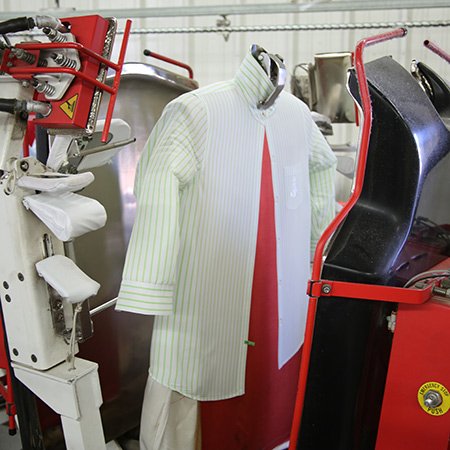Cleaning FAQ
We Get Asked A Lot Of Questions

Fun Facts
IS DRY CLEANING ACTUALLY DRY?
Dry cleaning is not dry; it’s wet. Instead of water, a blend of chemical solvents are used to clean. The solvents work better than water, removing stains without ruining fabric.
DOES CLUB SODA REMOVE STAINS?
Club soda may set stains and should be avoided. Do not rub the stain with water or even club soda. Simply bring the stained clothing to Victoria Cleaners as soon as possible.
WHAT CAUSES BUTTONS TO BREAK ON LAUNDERED SHIRTS?
Many buttons are constructed of materials that cannot handle the heat involved in professional shirt pressing. Buttons do break on occasion and we attempt to replace each and every one before it is returned to you.
Frequently Asked Questions
Dry cleaning uses fluids to remove soils and stains from fabrics. Among the advantages of dry cleaning is its ability to dissolve grease and oils in a way different from water. Natural fibers such as wools and silks dry clean beautifully, but can shrink, distort, and lose color when washed in water. Synthetic fibers like polyester also respond well to dry cleaning. However, with washing, they can retain oily stains. Dry cleaning helps to return garments to a “like-new” condition using precautions to prevent shrinkage, loss of color, and change of texture or finish.
Dry cleaning is not dry; it’s wet. Instead of water, a blend of chemical solvents are used to clean. The solvents work better than water, removing stains without ruining fabric.
Some labels state “Spot Clean Only”. Spot cleaning is basically what the word implies. A garment is hand cleaned only in the areas where spots are noticeable. Spot cleaning is performed when portions of the garment are not capable of withstanding normal cleaning methods. Some of today’s fashions include various trims that are unserviceable whether dry cleaned or wet cleaned.
Garments that are delicate, fancy, suede, leather or have noticeable damage, and household items require a release of liability simply due to the increased potential risk for damage during the cleaning process. Care labels provided on garments only cover the base fabric, not the trim (beads, sequence, lace, embroidery, etc.) that is added after the construction of the garment. Care labels on leather and household items also do not protect the consumer.
You should note any spills on fabrics before the garment is cleaned professionally. For example, if not pre-spotted, sugar residue will darken (caramelize) when heat is applied at pressing. The more information you can provide, the better your suit will look after cleaning and pressing.
The cellulose in all-cotton fabrics is prone to weakening by the chemicals found in antiperspirants. Also, sweat itself can damage clothes.
You may bring the skirt back to us and ask for spot treatment and redo. If you know the cause of the stain (wine, ink, etc.) that information will be helpful in the spotting process. Once a stain has been “set” with heat, we cannot guarantee complete removal and may ask you to sign a customer-consent form. In this case, calling attention to the stained area before cleaning probably would have prevented the discoloration.
One of the dry cleaner’s worst enemies is the “invisible stain” like spray from grapefruit, hair spray or perfume. These stains surface after dry cleaning and become very visible after processing. It is actually the heat associated with the dry cleaning cycle or pressing that makes the stains visible. Dry cleaning itself will not remove these and depending on the material, some can be removed by a technician. Some may never be removed. If you know of any such invisible stains, please point them out so that we may pre-treat the stain before dry cleaning.
Dry cleaners use complex procedures and special stain removal chemicals to remove stains. Stains are divided into two major categories: solvent-soluble stains and water-soluble stains. Different stains require different treatments and our stain removal technicians are trained to administer.
There are some stains that cannot be removed after contact with select fabrics. Many factors affect our ability to remove stains, such as age, temperature and consumer’s past attempts to wash or remove the stain.
Club soda may set stains and should be avoided. Do not rub the stain with water or even club soda. Simply bring the stained clothing to Victoria Cleaners as soon as possible.
Get the garment to your dry cleaner as quickly as possible. Be sure to explain specifically the cause of the stain. Dry cleaners use different methods to fight different stains and knowing the specifics will help achieve optimal results. Spot removal is not guaranteed but we will always do our best!
When exposed to solutions containing alcohol, some dyes bleed or change color. Hair sprays, deodorants and perfumes must be allowed to dry before dressing. Remove spills (blot, don’t rub) from beverages as soon as possible. Some dyes especially blues and greens on silk, are sensitive to alkalis. Many facial soaps, shampoos, detergents, and even toothpastes alkaline can cause color loss or change. Many times, these changes will not show up until after the dry cleaning process is complete. Many bright colors used on these fabrics can fade from exposure to sunlight and artificial light. Store garments in closets away from any lights or windows.
On the contrary, frequent cleaning prolongs the life of a garment. Not only do stains set with age, making the garment un wearable, but ground-in dirt and soil act as an abrasive, like sandpaper, causing rapid wear of fibers. Also, insects are attracted to soiled clothes and will cause additional damage.
Exposure to heat or the passage of time can cause stains from food, beverages, and other oily substances to oxidize and turn yellow or brown. Once stains become yellow or brown, they are much more difficult to treat and often cannot be removed. Some fabrics react negatively to common chemicals such as antiperspirant, perfume and aftershave. Applying these common chemicals before you dress can help avoid fabric breakdown or discoloration, but over a period of time damage can take place. Repeated contact to perspiration will eventually lead to permanent yellowing that is commonly seen on shirts and blouses.
Wool, silk and acetate fabrics are most appropriate for dry cleaning. Also any fabrics trimmed in suede or leather. Pieces embellished with fancy beading, pearls, rhinestones or sequins, fine “designer” knit suits and most sweaters—are great candidates too.
No. Dry cleaning can extend the life of your clothing. Food and beverage spills or tiny crumbs can attract insects and cause damage unless garment is dry cleaned. Colors will change as well if the original dye lot is not colorfast or also be noticed if matching pieces are cleaned with different solvents.
We believe it is best to follow the garment manufacturer’s suggestion and dry cleaning would probably yield the best results.
Many buttons are constructed of materials that cannot handle the heat involved in professional shirt pressing. Buttons do break on occasion and we attempt to replace each and every one before it is returned to you.
Federal laws require that all clothing manufacturers provide proper cleaning instructions attached by a care label. The labels are intended to provide information about the fabric from which the garment is made and special care instructions and how to clean it.
We accept cash, check, Visa, Master Card, American Express, Discover. We also offer monthly automatic debit payments for our regular customers directly from their checking account or credit card.
At Victoria Cleaners, we take great care to prevent this from happening. However, in such an unfortunate situation, just give us a call. We will re-deliver the complete order as soon as possible.
You can talk to our customer service people or contact your route salesman and reschedule delivery. Alternatively, you can always come to our plant and pick the garments up when you return.


